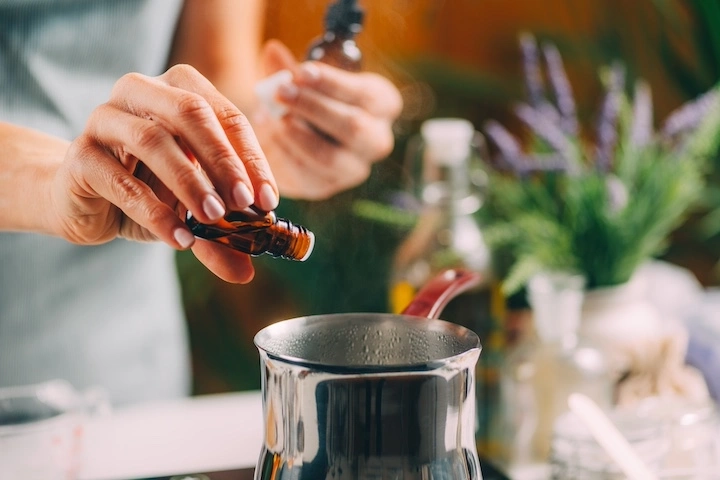
01 mai 2024
Landema, your eco-responsible partner
Essential oils have experienced a real craze in recent years, and for good reason: 100% natural, they offer a multitude of benefits. Whether you are an individual concerned with adopting a more natural beauty and wellness routine, or a professional in aromatherapy, cosmetics, health, or plants, it is essential to choose, use, and store your essential oils properly.
Indeed, behind their apparent simplicity lie very powerful and active products, which require following certain rules to reap all the benefits without risk. Quality, precautions for use, storage conditions: these are all criteria to know to become an informed and responsible user.
In this article, we offer you a complete guide to the best practices to adopt, from eco-responsible purchasing to the storage of your bottles, including the different methods of use adapted to each need. You will discover how to select quality essential oils, favouring criteria such as purity, botanical and geographical origin, or the extraction method.
We will then detail the main routes of administration (cutaneous, oral, respiratory, etc.) and the recommended dosages according to the uses. You will learn to use essential oils safely, respecting the specific precautions for use for certain sensitive groups such as children or pregnant women.
Finally, we will discuss the golden rules for preserving your essential oils in optimal conditions and prolonging their virtues over time. You will know how to protect them from light and heat, choose the most suitable containers, and properly manage the end of life of your bottles.
Whether you are a novice or an initiate, this article aims to give you all the keys to using essential oils like a pro, in an informed, safe, and responsible way. So, ready to learn more about these natural extracts with superpowers?
What you will find in this article:
Here are the 3 main lessons to remember from the article you are about to read:
- To choose a quality essential oil, you must pay attention to several criteria: purity (100% natural, complete, undiluted), precise geographical origin, organic label, brand reputation. These elements guarantee authenticity, traceability, and the absence of chemical contaminants. A quality oil is more effective and safer.
- The use of essential oils requires respecting precautions: choosing the right method of administration (cutaneous, oral, respiratory route) and the appropriate dosage, doing a preliminary test in case of allergy, not applying pure on mucous membranes, being vigilant for children, pregnant women, the elderly. Seek advice from a healthcare professional if in doubt or if taking concomitant medical treatment.
- To preserve the properties of essential oils over time, they must be stored in good conditions: protected from light and heat, in a tightly closed tinted glass bottle. Most keep for 3 to 5 years, except for more fragile citrus fruits (1-2 years). An expired essential oil can change in smell, color or appearance. Properly storing your essential oils allows you to fully benefit from their benefits.
In summary, becoming a responsible and informed user of essential oils requires paying particular attention to their selection (quality), use (safety) and storage (durability). It is under these conditions that we can best benefit from these precious plant extracts and use them with complete peace of mind on a daily basis.

I. Quality criteria for choosing your essential oils
To be sure to choose a quality essential oil, several essential criteria must be checked. Indeed, the quality of an essential oil conditions both its effectiveness and its safety of use. Here are the main points of vigilance to select the best essential oils.
Organic labels and certifications: a guarantee of eco-responsibility
Favouring essential oils derived from organic agriculture is a first guarantee of quality. Public labels such as AB (Organic Agriculture), or private ones like COSMOS, Nature & Progress or FFL (Fair for Life) certify that the plants have been cultivated without pesticides or chemical fertilisers, in compliance with stringent specifications monitored by independent organisations.
To learn more about these labels, you can read the article dedicated to ecological labels.
This is an important criterion for eco-conscious users concerned about the impact of their consumption or the choice of ingredients that make up their products in the case of professional use of essential oils.
Origin and traceability: favour local, sustainable, fair trade channels
Beyond the cultivation method, the geographical origin of aromatic plants greatly influences the composition of essential oils. Climatic conditions, the nature of the soil, sunshine are all factors that determine the presence and concentration of active ingredients.
It is therefore essential to know the exact origin of essential oils. Favour those from local channels, with transparent traceability from the plant to the bottle. Essential oils of Fine Lavender (Lavandula angustifolia), Maritime Pine (Pinus pinaster), Roman Chamomile (Anthemis nobilis) or Carrot (Daucus carota) are examples of essential oils that can be produced in Europe from cultivation to distillation, packaging and analyses.
Small passionate producers, engaged in a sustainable or even fair trade approach, are often a guarantee of excellence.
Extraction methods that respect the plant
The extraction method of essential oils is another crucial criterion. Steam distillation is the most widespread technique. It allows the aromatic essence to be collected without denaturing the plant compounds. Other processes such as cold expression, reserved for citrus zest, or hydrodistillation are also guarantees of quality.
Some producers take their environmental commitment to the point of paying attention to the heat sources they use for distillation. This is the case of the Biolandes Group, to which Landema.com belongs, which, at its Le Sen site in the Landes, produces steam in a closed and insulated circuit with a high-efficiency, very low-emission biomass boiler that burns wood residues recovered from waste from other activities (forestry and furniture production). The site thus strictly controls its discharges and its impacts on the environment.
Biochemical composition and chemotype: the keys to targeted effectiveness
Each essential oil has a unique composition of aromatic molecules which gives it its properties. We speak of active ingredients, classified into large biochemical families: terpenes or monoterpenes, sesquiterpenes, terpenic aldehydes, phenols, etc. When the extraction is of quality, we obtain what is called the totum, that is to say all the components naturally present in the oil.
For optimal effectiveness, it is necessary to ensure that this totum is complete and has not been denatured. The chemotype is essential information: it specifies the content of majority aromatic compounds which guide the action of the essential oil. For example, Linalool Thyme (Thymus zygis) essential oil will have a soothing effect due to its linalool content, while Thymol Thyme (Thymus vulgaris) will be stimulating thanks to its thymol concentration.
Finally, demand transparency from brands on the analyses (organoleptic, physico-chemical, chromatographic) carried out to control the quality and authenticity of each batch of essential oil. This is the guarantee of consistency in the composition.
At Landema.com for example, you will systematically obtain a certificate of analysis for the batch of each essential oil ordered.
In summary, to choose a quality essential oil, check its organic origin, its provenance and traceability, its extraction method and its detailed biochemical composition. Favour specialised brands that communicate in complete transparency on these quality criteria. It is under these conditions that you can fully benefit from the extraordinary virtues of essential oils, in complete safety.
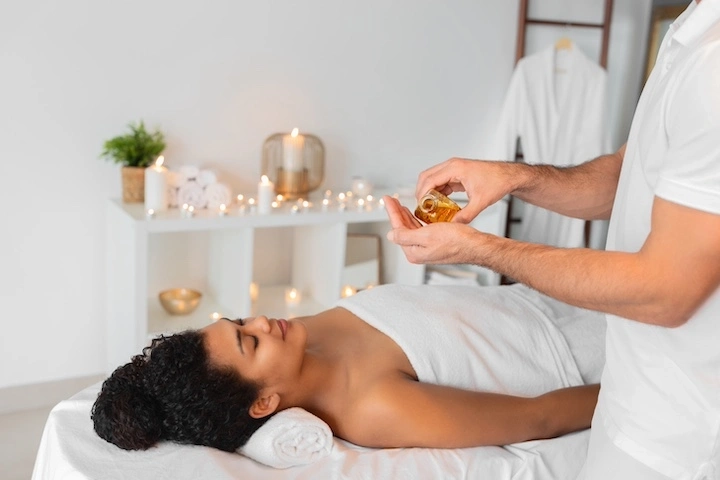
II. Precautions for use by type of use
Cutaneous route: dosages, vehicles and application areas
The cutaneous route is the most common and safest for using essential oils. However, it is essential to respect certain rules to avoid any risk of irritation or allergic reaction.
As a principle, always dilute essential oils in a vegetable oil (Jojoba, Sweet Almond, Hazelnut, etc.) or another suitable excipient (neutral cream, etc.). The recommended dosage is generally 1% for the face and up to 30% for targeted local applications.
Avoid applying essential oils to the most sensitive areas such as the eye contour, mucous membranes, genital parts.
In order to ensure that you are not allergic to an essential oil, do a test in the crease of the elbow before any new use. Find more advice and information on essential oil allergies in this article.
Babies, children, pregnant or breastfeeding women and the elderly require additional precautions, or even the advice of a healthcare professional. Inquire or consult before any use.
Atmospheric diffusion: duration, frequency and associations
The atmospheric diffusion of essential oils makes it possible to purify the air, create an atmosphere or act on emotions and concentration. Here again, a few precautions are necessary.
Choose a suitable diffuser (by nebulization, ultrasound, gentle heat, etc.) and of quality to preserve the aromatic molecules. In a room of 15-20 m2, diffuse in 30-minute sessions, 3 to 4 times a day maximum. Beyond that, ventilate regularly.
Depending on the desired effects or fragrance, you can even create synergies of essential oils adapted to your needs; you will then choose a maximum of 5.
Some essential oils are not suitable for diffusion (irritating, allergenic, etc.), such as essential oils rich in ketones. You will thus avoid diffusing the essential oils of True Cinnamon (Cinnamomum verum) and Chinese Cinnamon (Cinnamomum cassia), Atlantic Cedar (Cedrus atlantica), Clove (Eugenia caryophyllus), Peppermint (Mentha x piperita), Spearmint (Mentha spicata), Compact Oregano (Origanum compactum), Camphor and Verbenone Rosemary (Rosmarinus officinalis camphoriferum and verbenoniferum), Savory (Satureja montana) and Thymol Thyme (Thymus vulgaris).
Diffusion is not recommended in the presence of babies, children, pregnant women, people with asthma or epilepsy and certain pets. If you diffuse, do so for short periods in ventilated rooms.
Tips for the eco-conscious: Prefer cold atmospheric diffusion (nebulisation) which preserves the properties of essential oils. Use organic and local essential oils if possible.
Oral route: indications, contraindications and dosages
The ingestion of essential oils allows a rapid and powerful action but also presents more risks. It must remain punctual and supervised by a healthcare professional.
The dosages by oral route are of the order of 1 to 3 drops 2 to 3 times a day for an adult, to be diluted in a spoonful of honey, vegetable oil or on a neutral tablet, and always after meals. Do not exceed 2 weeks of treatment.
Many contraindications exist: children (<12 years old), pregnant or breastfeeding women, people on drug treatment (anticoagulants, etc.), epileptics, people with kidney or liver failure, etc.
Interactions with certain medications or dietary supplements are possible. Ask your doctor or pharmacist for advice before any ingestion.
Internal aromatherapy focus for experienced professionals: Reserve the oral route for specific indications (infections, digestive disorders, etc.) after having ruled out any contraindication. Choose chemotyped essential oils and adapted dosages. Favour short cures.
Other routes: respiratory, rectal, vaginal
Other more confidential routes of administration can be used under medical supervision. They allow local or rapid action.
The respiratory route (wet or dry inhalation) is useful for clearing the airways. Pour 2-3 drops into a bowl of hot water or on a handkerchief and inhale for 5-10 minutes up to 3 times a day. Beware of the risk of irritation.
Suppositories or ovules allow rapid passage of active ingredients and localised action (urinary, gynecological disorders, etc.). They are to be reserved for adults and require precise dosages.
Local (irritation, burns, etc.) or general (headaches, nausea, dizziness, etc.) side effects are possible. Respect the doses and contraindications for each route.
In summary, each route of administration of essential oils responds to precise rules of dosage, method of use and precautions. The advice of an aromatherapist and compliance with the recommendations make it possible to take advantage of their benefits in complete safety.
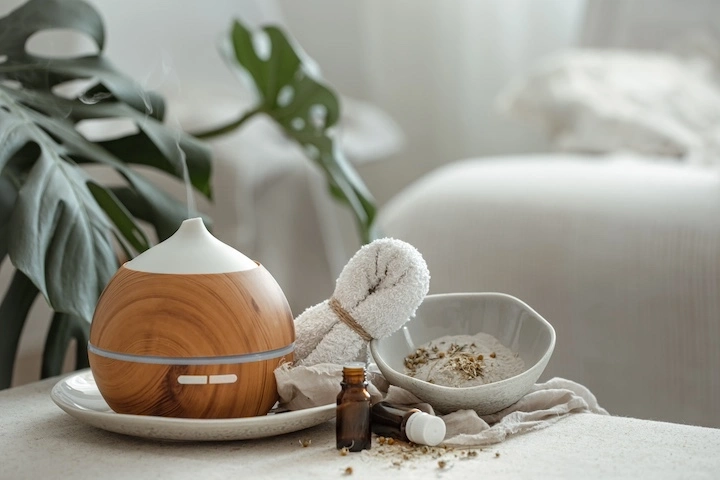
III. Storage rules: good eco-responsible practices
Optimal storage conditions: temperature, light, humidity
To sustainably preserve the properties of your essential oils, it is crucial to store them in proper conditions. Light, heat, and humidity are indeed the main factors that can alter aromatic compounds.
Keep your bottles in a dry, cool place (between 5 and 25°C) and protected from direct sunlight. An opaque cupboard or cabinet is perfectly suitable. Some fragile essential oils such as citrus fruits can be placed in the refrigerator to extend their shelf life.
Be sure to always close the bottles tightly after use to avoid evaporation and oxidation of essential oils in contact with air. Dropper caps allow you to take the right dose without contaminating the contents of the bottle.
Choice of containers: tinted glass, recyclable or reusable materials
Essential oils must imperatively be stored in tinted glass bottles (amber, blue or purple) which protect them from UV rays. Avoid plastic containers that can interact with aromatic molecules and denature them.
If possible, choose bottles made of recyclable glass and opt for reusable or biodegradable materials for packaging. Some brands offer refills to limit waste.
Eco-responsible tip: Give your empty bottles a second life by reusing them for your DIY cosmetic or household products. Glass is infinitely recyclable!
Shelf life: know the conservation times
The shelf life of essential oils varies according to their biochemical composition. Most can be kept for 3 to 5 years from the date of manufacture.
However, some are more fragile and oxidise more quickly, especially citrus fruits (Orange, Lemon, Mandarin...) which are to be used within 1 to 2 years. Floral waters or hydrosols have an even shorter shelf life of 6 months to 1 year.
Over time, essential oils can change in smell, color or appearance (deposit, cloudiness...). If in doubt about the quality of an essential oil, do not hesitate to discard it.
Eco-responsible tip: To avoid waste, buy your essential oils in small quantities according to your needs. Prefer local and seasonal oils to limit transport and packaging.
End of life: recycling and eco-responsible disposal
When an essential oil is expired or has lost its properties, it is important to dispose of it properly to limit its environmental impact. Floral waters can be diluted in large quantities of water before being poured down the drain.
For essential oils, it is recommended to take them to a recycling center or a pharmacy that collects this type of waste. You can also pour them onto an absorbent material (cardboard, cloth...) before throwing them in the trash.
Glass bottles should be rinsed and recycled in the appropriate container. Plastic pipettes and caps are to be thrown in the trash.
Eco-responsible tip: Some organic stores or aromatherapy brands set up collection points for your empty essential oil bottles. Do not hesitate to inquire to give them a second life!
In summary, to use your essential oils in an eco-responsible way over time:
- Store them in a cool, dry place protected from light
- Choose tinted glass bottles and recyclable materials
- Respect the shelf life of each oil and do not hesitate to throw away if in doubt
- Dispose of your bottles and expired oils appropriately by recycling or bringing them to a collection point
- Favour local, organic and seasonal oils to limit the ecological impact of your consumption.
By applying these simple principles, you will make your essential oils last while limiting waste and preserving the environment. Responsible use is at this price!
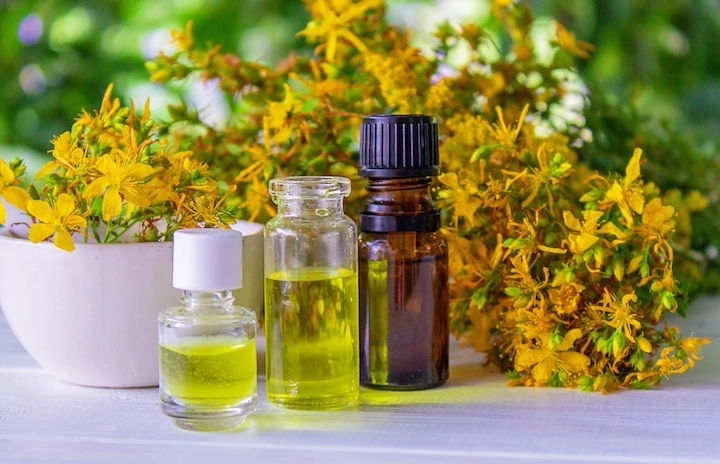
IV. Focus on vegetable oils: versatile and sustainable allies
Properties of the main vegetable oils
Vegetable oils are valuable allies in aromatherapy and natural cosmetics. Rich in essential fatty acids, vitamins and unsaponifiables, they have multiple beneficial properties for the skin.
Argan oil (Argania spinosa) is renowned for its nourishing and anti-aging virtues thanks to its vitamin E and fatty acid content. Jojoba oil (Simmondsia chinensis), very similar to sebum in composition, helps regulate oily skin. Sweet almond oil (Prunus dulcis), rich in omega-9, is ideal for sensitive and dry skin.
These vegetable oils are nourishing, repairing, softening and emollient. They strengthen the skin barrier, prevent dryness and irritation. A must for natural skin care.
Quality criteria and eco-responsible labels
To fully benefit from the virtues of vegetable oils, it is essential to choose quality products. Opt for organic oils, certified by labels such as AB or Cosmebio which guarantee cultivation without pesticides or chemical fertilisers.
Oils from fair trade and small local producers are also a guarantee of ethics and traceability. Choose virgin, cold-pressed, unrefined oils that preserve all their active compounds.
Professional uses: from cosmetics to phyto-aromatherapy
Vegetable oils are ingredients of choice for professionals in natural cosmetics and aromatherapy. They serve as excipients to dilute essential oils and facilitate their application on the skin.
In cosmetics, they are used as a base to formulate customized face and body care. They can be combined with essential oils to create aromatic synergies with targeted virtues: soothing synergy with Calendula (Calendula officinalis) oil macerate and Fine Lavender (Lavandula officinalis), firming synergy with Argan oil (Argania spinosa) and Geranium (Pelargonium graveolens).
DIY: recipes for eco-responsible macerates and massage oils
Vegetable oils also allow you to easily make your own homemade treatments. For example, you can prepare oily macerates by infusing dried plants such as St. John's Wort (Hypericum perforatum), Arnica (Arnica montana) or Calendula (Calendula officinalis) in a vegetable oil for a few weeks.
Also make your own personalised massage oils by mixing vegetable oils suited to your needs. For a relaxing massage, combine Hemp oil (Cannabis sativa) and Petitgrain bigarade essential oil (Citrus aurantium var. amara). For a decontracting massage, opt for a blend of St. John's Wort oil macerate (Hypericum perforatum) and Wintergreen essential oil (Gaultheria fragrantissima).
In summary, vegetable oils are must-haves in eco-responsible cosmetics and aromatherapy. Thanks to their exceptional properties and great versatility, they allow the creation of an infinity of natural, healthy and effective treatments, for the well-being of the skin as well as the planet.
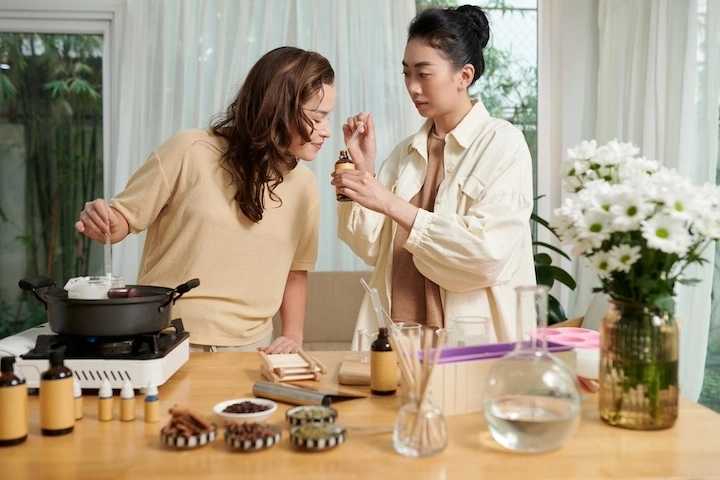
Quality, precautions, storage: the secrets of essential oil pros
In conclusion, choosing, using and storing essential oils responsibly is within everyone's reach, by following a few simple but essential rules. The quality of essential oils is the first criterion to consider, favouring 100% pure, natural and if possible organic products, whose origin and traceability are clearly established.
Precautions for use are the second pillar of a serene and beneficial use. Each essential oil has its specificities, indications and contraindications. It is crucial to respect the dosage advice and method of administration specific to each use, whether cosmetic, olfactory or aromatherapeutic. Particular vigilance is required for sensitive populations such as children, pregnant women and the elderly.
Finally, good storage conditions will allow the precious active ingredients of essential oils to be preserved over time. Protected from light and heat, in tightly closed tinted glass bottles, most can be kept for several years without losing their virtues.
Beyond these very concrete aspects, a responsible use of essential oils is part of a global approach of respect for life and the planet. Favouring local, organic, fair trade channels means supporting sustainable and ethical production that preserves ecosystems and traditional know-how.
For health, wellness or beauty professionals who wish to integrate essential oils into their practice, continuous training and scientific monitoring are essential. Knowledge in this field is evolving rapidly, and only up-to-date expertise can guarantee optimal use of essential oils.
Whether you are an occasional user or an experienced practitioner, essential oils are wonderful natural allies that must be learned to tame with curiosity, caution and respect. A beautiful philosophy to take care of oneself, others and our environment!
Items that could
interest
Our essential oils
will simplify your life
Your wishlist
You must be logged in to post a comment.
Login, or create an account
There is no comment for this article yet